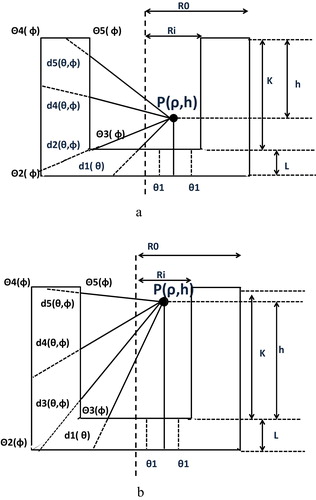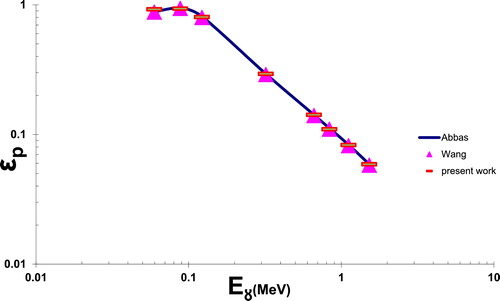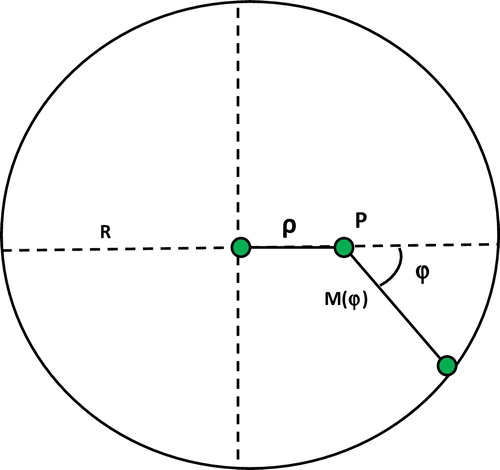 ?Mathematical formulae have been encoded as MathML and are displayed in this HTML version using MathJax in order to improve their display. Uncheck the box to turn MathJax off. This feature requires Javascript. Click on a formula to zoom.
?Mathematical formulae have been encoded as MathML and are displayed in this HTML version using MathJax in order to improve their display. Uncheck the box to turn MathJax off. This feature requires Javascript. Click on a formula to zoom.Abstract
In this study, direct mathematical formulae are found for measuring the full-energy peak efficiency of an HPGe well-type detector, and the values of the measured efficiencies are compared with published studies on the old experimental and theoretical methods with good agreement. In this new approach, the path length d(θ, φ) is derived as a function of the polar angle θ and the azimuthal angle φ, which will reduce the mathematical formulae to a simple and compact shape.
1 Introduction
Well-type HPGe and NaI (Tl) detectors are a suitable choice when low gamma activity samples need to be measured with a good energy resolution. Previously, gamma detector efficiencies were measured [Citation1–Citation20] using the spherical trigonometry technique. Recently, Abbas [Citation21,Citation22] introduced a new approach involving the determination of the path length d(θ,φ) covered by a photon inside the detector's active volume and the geometrical solid angle Ω. In this new approach, the path length d(θ,φ) is derived as a function of the polar angle θ and the azimuthal angle φ. This procedure will reduce the mathematical formulae to a simple and compact shape, and the integration over the azimuthal angle φ will always be from 0 to 2π [Citation23,Citation24]. Most importantly, it calculates the well-type detector efficiencies without the need for standard sources, as is the case for experimental methods, or optimisation of the detector parameters, as required for simulation methods. The study describes below involves the use of a new direct analytical expression to calculate the efficiencies of the well-type detector. Thus, we will measure the well-type HPGe detector efficiencies using this new method for a non-axial point and extended circular disc and compare the results with the previous work (old method).
2 Mathematical method
The basic formula of the efficiency with respect to the point source can be expressed as follows:(1)
(1) where μ is the attenuation coefficient of the detector material; and d is the path length travelled by a photon through the detector active medium. fatt is the attenuation factor that determines the photon attenuation by the source container and the detector end cap materials, which can be expressed as follows:
(2)
(2) where μj is the attenuation coefficient of the jth absorber for a gamma-ray photon [Citation17]; and δj is the path length of the gamma photon through the jth absorber. The fatt factor is applicable to the full-energy peak efficiency or photo peak efficiency, which is the efficiency for producing only full energy peak pulses instead of a pulse of any size for the gamma ray, but not to the total efficiency (the ratio of the total number of counts in the spectrum to the number of photons with energy emitted by the source).
The circular disc efficiency can be given by the equation as follows:(3)
(3) where S is the disc radius; and ɛ is the point source efficiency.
introduces the distance M(φ), which is the distance between the projection of the non-axial point source and any point lying on the circumferences of the inner circle Mi(φ) and the outer circle Mo(φ) of the well-type detector, where M(φ) is given by .
The source is located inside the detector at a position h, and the non-axial point efficiency can be calculated based on five different path length covering distances (di, i = 1, 2, 3, 4 and 5) considering the gamma ray emitted from the source and entering the detector, as indicated in , as follows:(4)
(4)
(5)
(5)
(6)
(6)
(7)
(7)
(8)
(8)
Fig. 2 Dimensions of the detector and the path of the photons from the source to the detector surface.

The polar angle (θ) as a function of the azimuthal (φ) angle can be expressed as follows:(9)
(9)
(10)
(10)
(11)
(11)
(12)
(12)
(13)
(13) where
(14)
(14)
(15)
(15)
The primary idea behind this method is that the azimuthal angle φ ranges from zero to 2π for a certain value of θ. Thus, the result of the non-axial point efficiency using this method can be obtained as follows:
1- For the case of (θ3 < θ2)(16)
(16) with
(17)
(17) 2- For the case of (θ3 > θ2)
(18)
(18) with
(19)
(19)
3 Result and discussion
For a well-type HPGe detector with parameters reported by Abbas [Citation17] and energies from 0.0595 to 1.524 MeV, the photo peak efficiencies are calculated using the current study and compared with those obtained by theoretical and experimental data for a circular disc source with a radius = 0.62 cm, as indicated in . lists the values of the photo peak efficiency of the experimental and theoretical methods (old method and new one). The percent deviation between the theoretical new method and the experimental efficiency values is less than 0.5%, and the obtained results confirm that our current method is useful for measuring the efficiencies of the well-type detector.
Fig. 3 Comparison of the experimental [Wang] and the old theoretical method [Abbas] and the current theoretical data of the photo peak efficiency (ɛp) as function of the gamma ray energies (E8).

Table 1 Experimental and theoretical full energy peak efficiency values; μP is the attenuation coefficient of the photo peak.
4 Conclusions
We have calculated the full-energy peak efficiencies using a new mathematical technique and compared them with those obtained by the published experimental data of Wang et al. [Citation7] as well as the theoretical data of Abbas [Citation17]. The percent deviation between the experimental and the theoretical (new method) techniques in study is less than 0.5%.
Notes
Peer review under responsibility of Taibah University.
References
- O.SimaAppl. Radiat. Isot.471996919923
- O.SimaD.ArnoldAppl. Radiat. Isot.471996889893
- O.SimaD.GurauAppl. Radiat. Isot.70201221412143
- H.FurciM.ArribereS.R.GuevaraNucl. Instrum. Method A7052013132139
- G.NicolaouAppl. Radiat. Isot.742013912
- F.CourtineS.SanzelleT.PilleyreD.MiallierRadiat. Meas.6120147882
- T.K.WangI.M.HouC.L.TsengNucl. Instrum. Method A4251999504515
- Y.S.SelimM.I.AbbasM.A.FawzyRadiat. Phys. Chem.531998589592
- Y.S.SelimM.I.AbbasRadiat. Phys. Chem.5820001519
- M.I.AbbasM.M.BasiouniAm. Inst. Phys.CP4501999268272
- M.I.AbbasRadiat. Phys. Chem.60200139
- M.I.AbbasY.S.SelimNucl. Instrum. Method A4802–32002649
- M.I.AbbasS.S.NafeeY.S.SelimRadiat. Phys. Chem.752006729
- M.I.AbbasJ. Phys. D: Appl. Phys.3920063952
- L.PibidaS.S.NafeeM.UnterwegerM.M.HammondL.KaramM.I.AbbasAppl. Radiat. Isot. J.652007225
- M.I.AbbasNucl. Instrum. Method B2562007554
- M.I.AbbasAppl. Radiat. Isot.552001245252
- M.I.AbbasNucl. Technol.168200941
- Y.S.SelimM.I.AbbasRadiat. Phys. Chem.44119941
- M.I.AbbasNucl. Instrum. Method A6212010413418
- M.I.AbbasNucl. Instrum. Method Phys. Res. A201010.1016/j.nima.2010.05.025 (in press)
- J.H.HubbellS.M.SeltzerNISTIR 5632, USA1995
- M.I.AbbasNucl. Instrum. Method Phys. Res. A6222010171175
- M.I.AbbasNucl. Instrum. Method Phys. Res. A615201048

